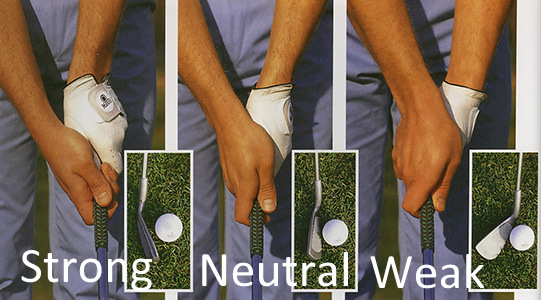I have used the same golf grip for about 15 years now. After trying all three, I settled on the interlocking grip.

I have talked about this in the past, but I have also played with my hand position and met little success. However, I have found that many amateurs like to tinker (or adjust) with their grip on the golf course as a means to try and improve their golf swing. I think this process is folly, but not my place to comment on their own path to success.
The fundamental aspect of the golf grip is something all golfers decide for themselves. However, there seems to be an innate requirement to move our hands slightly in one direction or the other in order find the most comfortable position. This adjustments are not to be confused with intentionally adopting a strong, weak, or neutral grip position. These provide a specific result, but not really considered tinkering.

On a side note, I use a neutral grip and found I cannot play a strong or weak hand position with any success.
Okay, back to our discussion. I have watched players adopt a weak hand position with the lower hand and a strong position with the top (and vice versa). I have watch players tuck their thumbs under the shaft and hold the club like a baseball bat. I have even watch players only use one hand when chipping. I have see so many variances that I don’t have the time to mention them all. But sometimes it was quite painful watching my playing partners attempt different hand positions.
After watching this painful process for a long time, I only have one piece of advice. Head to the range and first select the grip you want to use by hitting 20 golf balls with each grip. After this and you are feeling ‘comfortable’ it is time to adopt a strong, neutral and weak grip. During each new hand position, hit another 20 golf balls. Adopt which hand position provides the most comfort and ball striking results.
This short, but extremely important, process is only the first step to adopting a grip. It will take much practice and play to cement your final golf grip. But for now you setting the foundation for success later in your game. You can stop tinkering with your grip and focus your efforts on swing mechanics.
Tinkering with our golf grip is a fundamental past-time of all players. Unfortunately, doing this while playing is a recipe for disaster. After making my change to the neutral, interlocking grip, I remember it was months before it felt natural and comfortable. Now, I never tinker with my grip, there is no need.
Do you tinker with your golf grip?
I am a grateful golfer! See you on the links!
I used to have a weak or neutral grip. I’ve strengthened it as part of my first lesson with Nicky. This allows me to get a flatter wrist at the top and a bit of a bowing action with my left wrist. This is the hand position for most modern golfers. It’s been hard to learn it and stick with it. Old habits die hard. But I’m there most of the time. So – YES I do change my grip but I alway start with interlocking.
LikeLiked by 1 person
Linley
You are changing your grip in the right way by seeking a professional to help. They will help speed up the learning curve and reduce the frustration. Let us know how things work out.
Cheers Jim
LikeLiked by 1 person
I have tinkered with my grip over the years but not recently. I have settled on interlocking strong grip for past 20 years. Interlocking because it feels more natural and comfortable than the others and strong because I’m a natural fader and strong grip allows me to hit a small fade instead of a slice.
LikeLike
David,
I have found that a strong grip, even slightly, results in a big old hook. Your solution to reduce the fade is exactly right as long as your grip is not too strong. Then trouble can ensue.
Cheers Jim
LikeLike
Jim, I will tweak grip pressure but keep the fundamentals consistent. Been playing the overlap since day one.
Thanks,
Brian
LikeLike
Thanks Brian, It seems that most mature players have settled on a grip and do not change it much. Makes sense to me.
Cheers Jim
LikeLiked by 1 person
I use overlap because interlocking leaves me with a sore finger before the round is over. And I too went through a grip change that took me 6 months to get over so I’m not interested in playing around too much there either. I will say though that I do allow my trail hand to move a little depending on the shot shape I want. A little stronger for a draw and weaker for a fade. That tends to help me rather than hurt though.
LikeLike
Kevin
I have tried moving my hands slightly and it does not work well for me at all. It is the nature of our swings that allows us to adjust and be successful. My baby finger of my right hand used to get sore, but not anymore because I have lightened my grip. The smallest things seem to make the biggest difference.
Cheers Jim
LikeLike